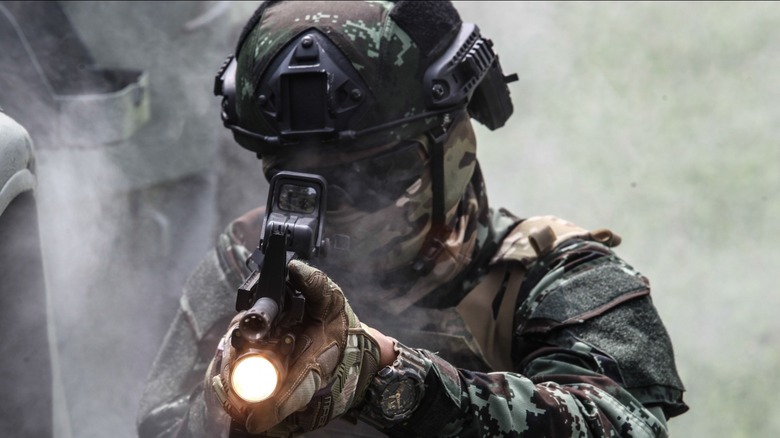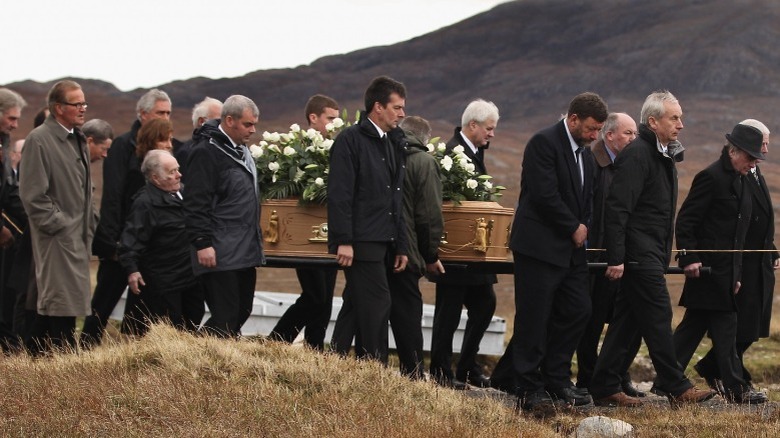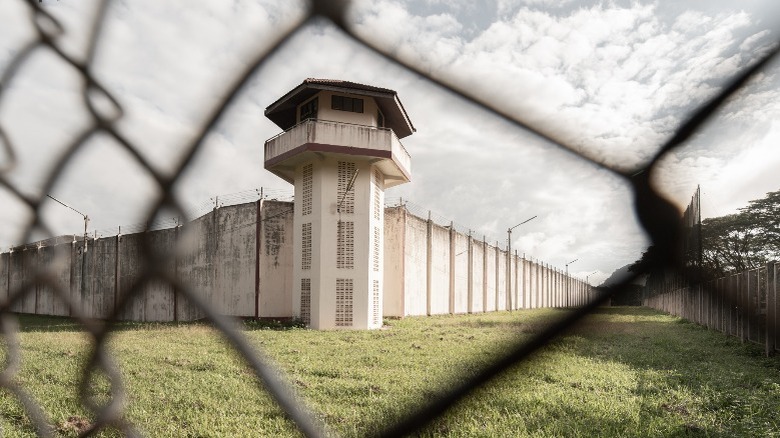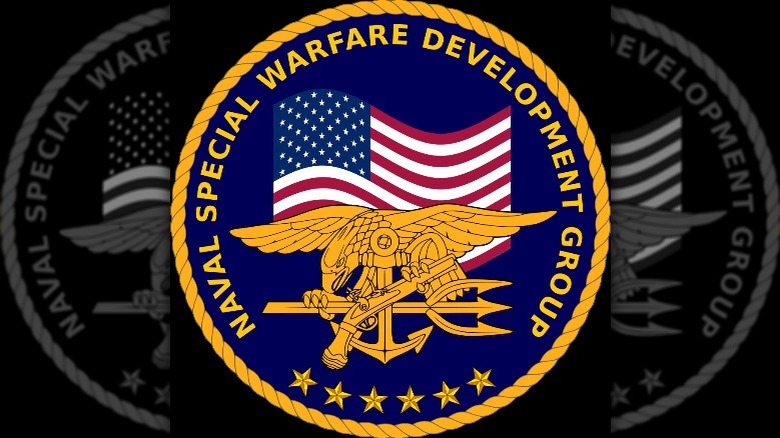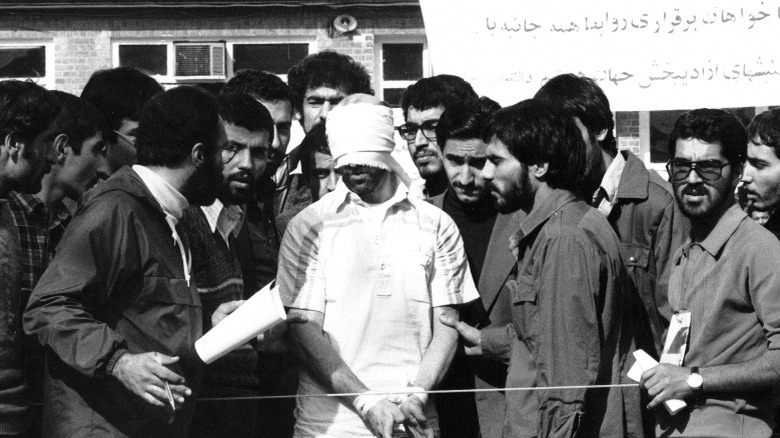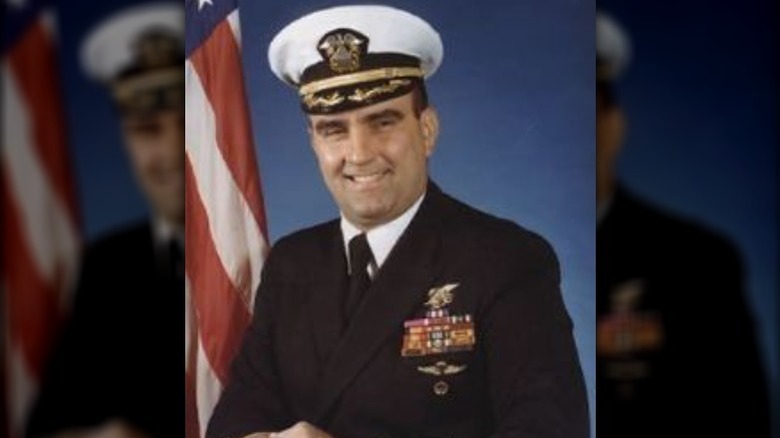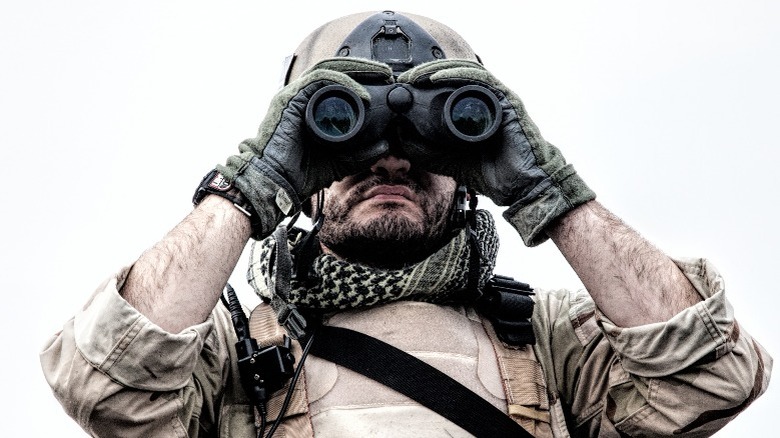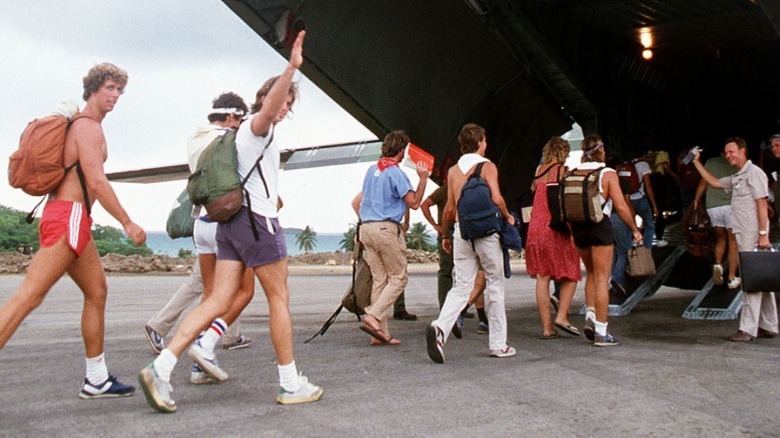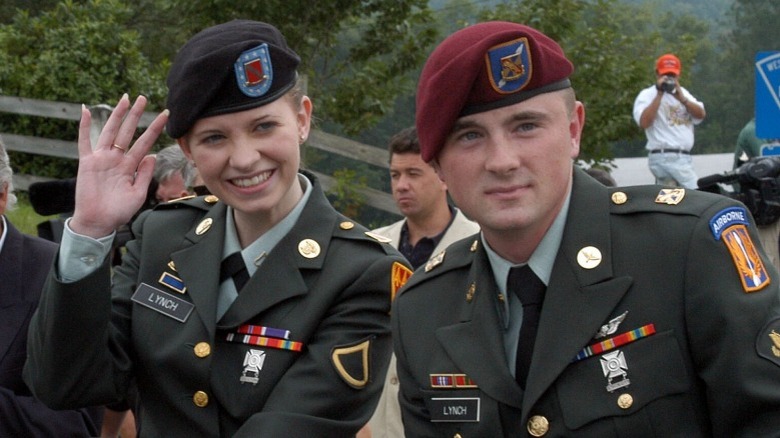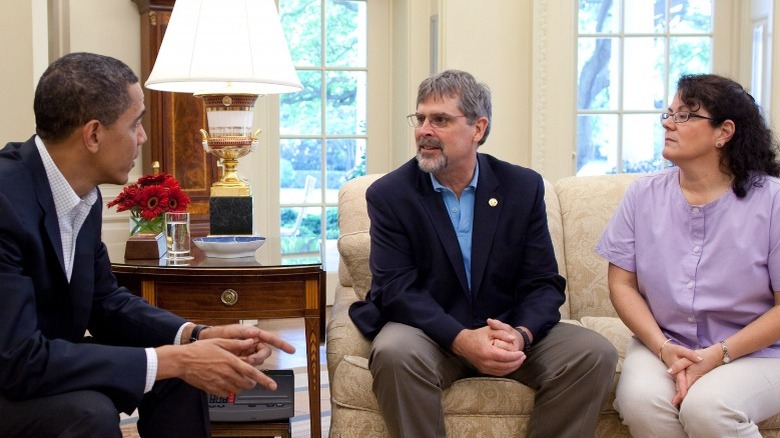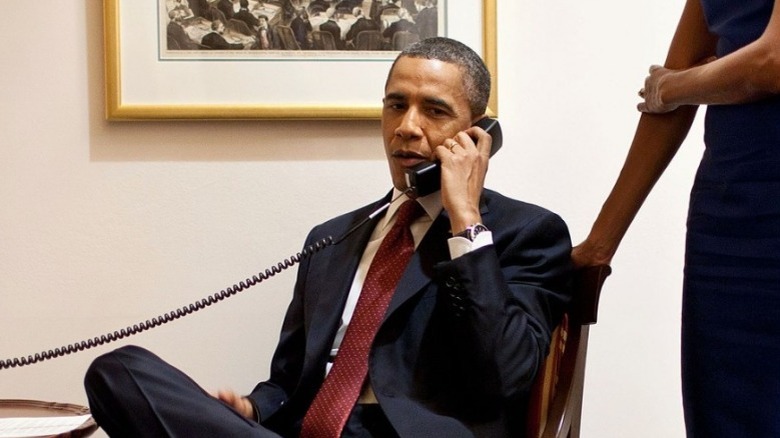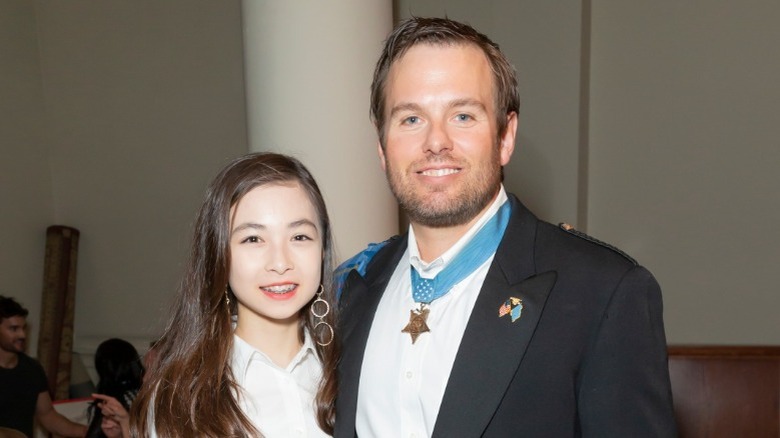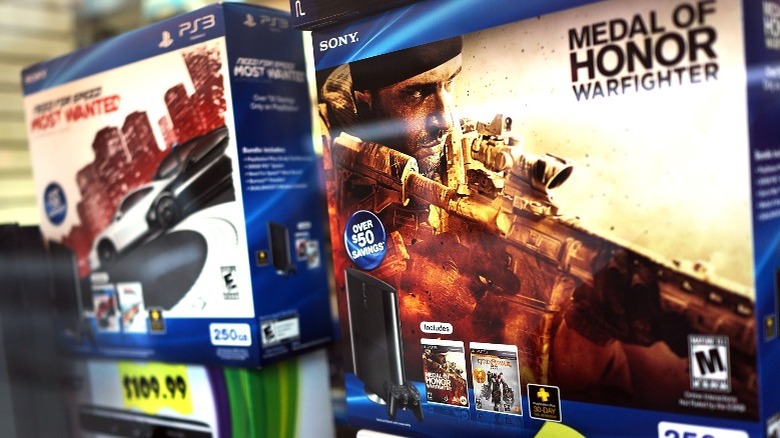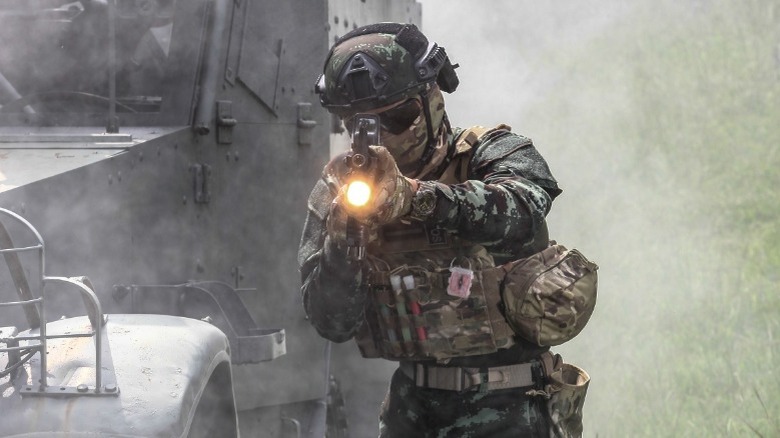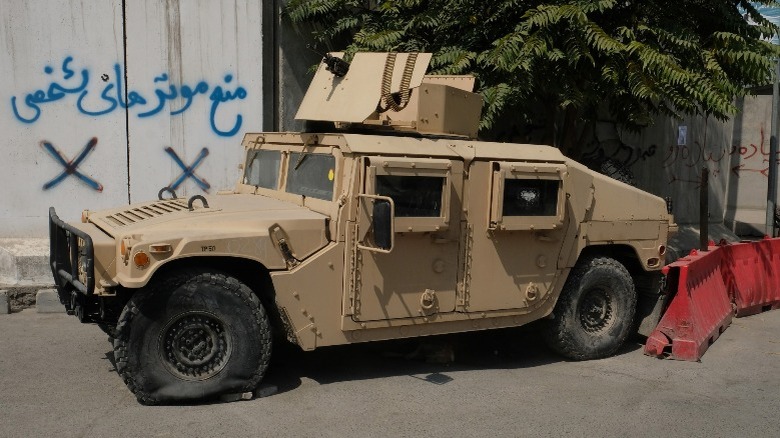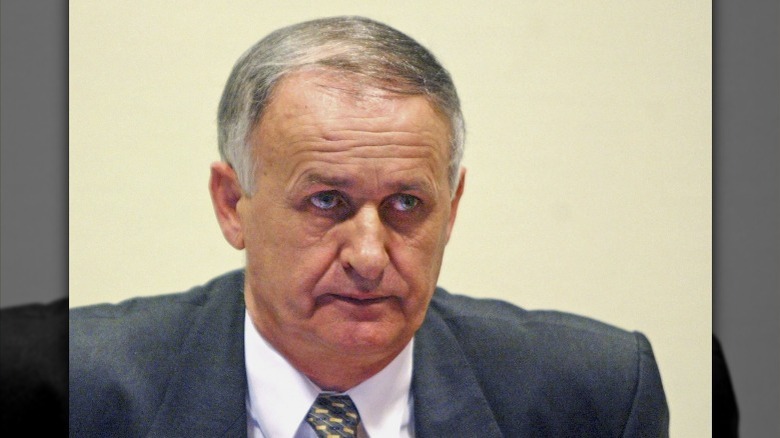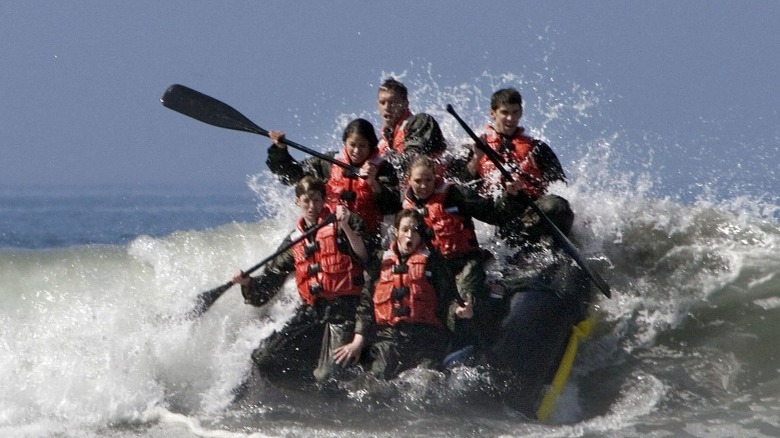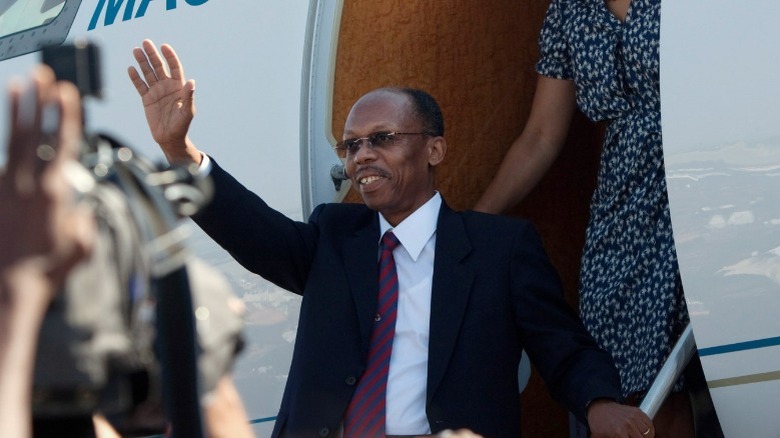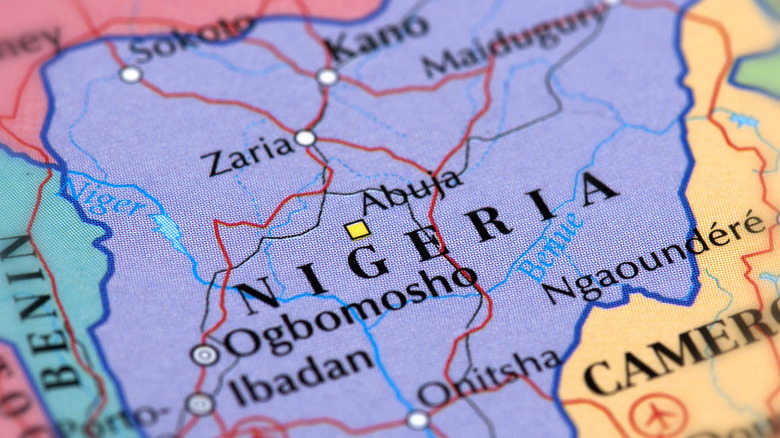The Untold Truth Of SEAL Team Six
SEAL Team Six has found a special place in U.S. military lore. Known for their exploits during the War on Terror in Afghanistan and Iraq, SEAL Team Six has developed a reputation as the one of the hardest working and most dangerous units in the entire Navy. Many Americans first learned about SEAL Team Six in 2011 in the aftermath of the assassination of Osama Bin Laden, which SEAL Team Six carried out and executed (per Military.com). Their operations and history are highly classified, and it has only been in small trickles and leaks that any information on them has reliably made its way to the public.
According to Business Insider, SEAL Team Six has been involved in operations since the 1980s and operates under the Joint Special Operations Command (JSOC), which itself operates as part of the overall U.S. Special Operations Command. SEAL Team Six makes up only one component of the JSOC: The other three are the Army's Delta Force, the Army's Intelligence Support Activity (ISA), and the Air Force's 24th Special Tactics Squadron (24 STS). Together, all four of these groups carry out secret and special ops missions around the globe. SEAL Team Six in particular is composed entirely of Navy SEALs, and along with the rest of JSOC, they are the first response to danger around the world. This is the untold truth of SEAL Team Six.
SEAL Team Six botched a rescue in 2010
In early October 2010, members of SEAL Team Six attempted to rescue British aid worker Linda Norgrove who had been kidnapped in Afghanistan. Taliban militants had abducted Norgrove and three of her Afghan colleagues a few weeks earlier while they were doing humanitarian work (per The Guardian). SEAL Team Six was called in to rescue Norgrove from her captors in what was seen as an almost impossible mission. Norgrove died in the attempted rescue, and initial reports claimed that she had been killed as the result of one of her kidnappers detonating a bomb vest. However, within days it came to light that she had actually died as the result of a hand grenade thrown by a SEAL Team Six member.
According to The Guardian, SEAL Team Six stormed the compound and immediately took out the six militants who were holding Norgrove hostage. However, they failed to notice that Norgrove herself was standing in close vicinity with the militants they were firing at. One of them threw a grenade at the kidnappers, and it instantly killed Norgrove in the blast. The SEAL did not admit to throwing the grenade and killing Norgrove until he was directly questioned, which caused a minor international scandal between the U.S. and British governments. The tension was eventually resolved and the SEAL was expected to be punished for the incident.
In 2017, two members of SEAL Team Six were indicted for murder and sentenced to prison
On June 4, 2017, 34-year-old U.S. Special Forces Staff Sgt. Logan J. Melgar was found dead in Bamako, Mali. Melgar was in Mali working with other Green Berets training the local forces and working against insurgents. According to the New York Times, authorities immediately suspected foul play and ordered an investigation right away. The coroner ruled Melgar's death a homicide and said he died from strangulation.
By that November, the military had formally charged two former SEAL Team Six members in Melgar's homicide (per the Daily Beast). Petty Officer Anthony E. DeDolph and Chief Petty Officer Adam C. Matthews, along with two Marine Raiders, were indicted on charges including felony murder, conspiracy, obstruction of justice, burglary, hazing, lying to investigators, and involuntary manslaughter. According to the charges, all four of the accused had procured duct tape earlier in the day, which they used to hold down Melgar while they strangled him to death. The Beast reported that a rift between Melgar and the SEAL Team Six members had developed over DeDolph and Matthews' alleged stealing of money and use of sex workers.
Matthews was ultimately sentenced to one year in prison for the incident, and his murder charges were dropped in exchange for his testimony against the other defendants (per NBC). DeDolph was sentenced to 10 years in prison, bussed down to E1, lost pay, and received a dishonorable discharge from the Navy (per USNI).
They haven't been named SEAL Team Six since the 1980s
Though colloquially known as SEAL Team Six, the actual nomenclature of this group is a bit more complicated. According to GlobalSecurity.org, SEAL Team Six was initially conceived in 1980. There were two Navy SEAL teams at that point, Team One and Team Two. While Team One was working on training for more conventional counter-terrorism operations, Team Two formed a group that specifically focused on maritime training, in case that type of operation would be needed. The group formed by Team Two was first known as Mobility Six (MOB Six), but it was renamed SEAL Team Six shortly after. Within six months, the unit was already considered ready for action.
In 1987, SEAL Team Six was officially disbanded and then reincorporated under the new moniker United States Naval Special Warfare Development Group, or DEVGRU (per History). In 2010, The Atlantic reported that DEVGRU had once again changed their name to confuse enemies. However, since nobody had publicly referred to the new cover name, officials have purposefully not revealed what it is. JSOC generally changes the cover names for DEVGRU and other units under their command every few years. They do so to add another layer of secrecy and security, and to obfuscate as much information as possible.
SEAL Team Six was created in the aftermath of the Iranian Hostage Crisis
In late 1979, in the midst of the Iranian Revolution, a group of Iranian students burst into the U.S. Embassy in Tehran and took more than 60 Americans hostage (pictured above, per History). In an effort to rescue them, President Jimmy Carter authorized the rescue mission "Operation Eagle Claw." The mission itself was a complete failure and eight U.S. service members died in a helicopter accident. In the aftermath, the Navy purposefully created SEAL Team Six to be a dedicated task force to fighting terrorism around the globe (via History). Operation Eagle Claw had been conceived at the last minute, and military commanders wanted a unit that would always be ready for such operations at a moment's notice.
The New York Times reported in 1984 that the Defense Department under President Ronald Reagan had created several counterterrorist units in recent years, including SEAL Team Six. Joe Biden was then a Senator for Delaware, and was quoted as saying there was little known about it in Congress at the time, but they were trying to learn more. The article also reported that SEAL Team Six was based out of the Little Creek Naval Amphibious Base near Norfolk, Virginia, and that members dressed as civilians and grew long hair and beards. Apparently, one of them died during a skydiving accident, and other members instructed the doctors at the hospital to stop from turning over the body to civilian authorities due to "national security reasons."
Controversial former Navy SEAL Richard Marcinko helped create SEAL Team Six
According to an excerpt from the book "Code Over Country: The Tragedy and Corruption of SEAL Team Six," by Matthew Cole, former Navy SEAL Richard Marcinko was ordered to create SEAL Team Six in 1980 (via Rolling Stone). Marcinko was a high school dropout who had joined the Navy in the 1950s and was a veteran of the Vietnam War. He chose the name for SEAL Team Six; even though there were only two SEAL teams at the time, Marcinko thought changing the name of the second team to Team Six would confuse the Soviet Union.
Marcinko himself would be the subject of a criminal investigation during his time as chief. According to Orr Kelly's "Brave Men, Dark Waters: The Untold Story of the Navy SEALs," in the spring of 1986, the Naval Investigative Service had begun looking into Marcinko's activity involving fake travel reimbursements and kickbacks. Marcinko and John Mason, another original SEAL Team Six member, had concocted a scheme where they received $100,000 in kickbacks from a deal involving the army buying grenades from a third party. He was indicted in 1989 and in 1990 was found guilty of conspiracy, bribery, making false claims against the government, and conflicts of interest. He was sentenced to 21 months in prison and a $10,000 fine, but he was released just a year later.
In the 1980s, they infiltrated U.S. military bases to test vulnerability
In 1984, after Richard Marcinko had relinquished command of SEAL Team Six, he was given orders to form a new secret operations unit. According to his autobiography "Rogue Warrior," Navy Adm. James "Ace" Lyons ordered Marcinko to create a new unit that specialized in figuring out the weaknesses of Navy bases around the world. Marcinko was tasked with breaking into Naval bases to expose their vulnerabilities. The operation, officially called OP-06D, was nicknamed Red Cell by Marcinko, and it was made up completely of former SEAL Team Six members, with one exception. They would go around to different bases, infiltrating supposedly secure areas and planting fake bombs that would "explode" and cripple communications. One time, when they released a series of smoke grenades, the explosions caught the attention of the local fire department who came rushing down to the base.
According to "Brave Men, Dark Waters," Red Cell gave the bases full warning of each of their planned attacks, but they still managed to infiltrate anyways. Many of the participants on the bases felt terrorized by the incidents, including one security officer who alleged he was stuffed face-first in a toilet and given a cracked rib. Marcinko saw Red Cell as a new version of SEAL Team Six he could command, and they trained the same way and continued to utilize the same tactics.
Their early days involved a lot of heavy drinking
In the early years of SEAL Team Six, when Richard Marcinko was still chief, they gained quite a reputation for drinking. According to "Brave Men, Dark Waters," Marcinko and the members of SEAL Team Six were constantly getting into ordeals that involved excessive alcohol use. They would frequently hang out at local bars and they had a habit of fighting, both with each other and civilians. They even tried to show off by eating broken glass. Members were frequently arrested for street brawling and public intoxication, among other alcohol related charges. One former SEAL Team Six officer reportedly said that Marcinko all but required heavy drinking to be a part of his unit.
The book "Code Over Country," (via Rolling Stone) claims that Marcinko told him that he purposefully used alcohol during his recruiting process. He would start drinking heavily with whoever the new recruit he was interviewing, and if the new guy was not able to keep up he was considered useless. Marcinko's recruiting process was strict in other ways, too. In his autobiography "Rogue Warrior," Marcinko recalled an incident where he kicked a guy out of his unit for refusing to shave his beard.
They were secretly involved in the invasion of Grenada in 1983
In October 1983, the U.S. invaded the island nation of Grenada after a communist coup. President Reagan ordered the invasion partially in order to evacuate several American students who were attending school on the island (pictured above). According to "Brave Men, Dark Waters," Grenada was the first real live test of SEAL Team Six's capabilities. They were given three objectives; they were to seize the Government House, place beacons on an airfield, and disable a radio transmitter the rebels were using. In his book "The U.S. Invasion of Grenada: Legacy of a Flawed Victory," Philip Kukielski looks at the invasion and Lt. Donald "Kim" Erskine, the head of SEAL Team Six that day. The first mission, to take out the radio transmitter, failed conclusively and the team had to make a quick escape under fire.
The second mission, to protect the Governor General of Grenada Paul Scoon, also did not go according to plan (per "Brave Men, Dark Waters"). While the SEALs were able to protect Scoon and secure the Government House, they were pinned down by heavy fire from the attacking Grenadian Army. Miraculously, they were able to hold their position, and the following morning they escaped when a marine company came and assisted them. Four SEALs died during the invasion; Machinist Mate 1st Class Kenneth Butcher, Quartermaster 1st Class Kevin Lundberg, Hull Technician 1st Class Stephen Morris, and Senior Chief Engineman Robert Schamberger.
SEAL Team Six rescued an Army POW during Operation Iraqi Freedom
In the early days of Operation Iraqi Freedom, the U.S. Army engaged in many fierce battles and firefights with the Iraqi Army. During a patrol of an area in Nasiriyah, Iraq, a group from the 507th Ordnance Maintenance Company took a wrong turn, and they were ambushed and kidnapped by members of the Iraqi Army. Per the New York Times, 15 members of the 507th had been kidnapped by the army and taken prisoner, and some of them were killed right away. They were shown looking terrified in a forced recording shortly after their kidnapping.
SEAL Team Six was part of a large rescue force that included Army Rangers, Green Berets, and marines. They got word on the location of one of the prisoners, PFC Jessica Lynch (pictured above), and they rescued her from an Iraqi hospital less than two weeks after her kidnapping (via CNN). They found her in Saddam Hospital which had also been acting as a military command post. When they stormed the hospital, they found Lynch lying in a bed with multiple gunshot wounds, broken legs and arms, and a fractured back. During the mission, SEAL Team Six also helped recover the bodies of nine American soldiers who had been killed in the previous weeks.
They have almost mythical sniper skills
In one of the most famous incidents in special operations history, SEAL Team Six participated in the 2009 rescue of Captain Richard Phillips (pictured above) from the Maersk Alabama (via "Pirate Alley: Commanding Task Force 151 Off Somalia" by retired Rear Adm. Terry McKnight), but their role is still so classified that McKnight, despite being the leader of the entire task force, was still not entirely clear about how they even got there. A group of SEALs had been stationed at the Horn of Africa and originally dispatched to the scene to hold down the situation until SEAL Team Six could arrive from the states. There is no official record of when SEAL Team Six took over for the other SEALs, but eventually they arrived with sniper rifles in tow.
SEAL Team Six attached their boat to the pirate's lifeboat and were slowly pulling them closer. When they were 25 meters away, three members killed all three of the Somali kidnappers with simultaneous headshots (via "Pirate Alley"). They shot them in the head to stop them from having involuntary muscle spasms that could have made them accidentally fire their weapons and injure Phillips. The difficulty and precision of the shot cannot be understated. They were operating at night, from a boat moving on the open ocean, and three of them simultaneously fired single headshots to kill their targets. There were no mistakes, and no missteps. Then, just like they came, SEAL Team Six vanished from the scene into thin air.
They rescued a Danish aid worker from Somalia
According to CNN, in January 2012, SEAL Team Six made yet another daring rescue. Somalian pirates had kidnapped American aid worker Jessica Buchanan and Danish aid worker Poul Hagen Thisted from the Somali village Galkayo. To save them, SEAL Team Six secretly parachuted under the cover of darkness into a nearby village before proceeding on foot to their location. There, they encountered nine armed gunmen, and after a brief firefight the SEALs eliminated all of them.
None of the SEALs suffered any casualties, and both Thisted and Buchanan were not harmed in the rescue (via the New York Times). Previously, the kidnappers had refused offers ranging up to $1.5 million to let the hostages go. Other ransoms had been noted to have gone as high as $10 million, and the U.S. government was worried about their harsh treatment and deteriorating health conditions. The SEAL Team Six attack was carried out with brutal efficiency, and just as quickly as the commandos came, they left and whisked away the two hostages with them. They were flown back to safety, and that night, President Barack Obama informed Buchanan's father that she was safe as the result of the rescue (pictured above).
One of them received a Medal of Honor in 2016
In 2016, Chief Special Warfare Operator Edward C. Byers was awarded the Medal of Honor (pictured above) for his actions during a 2012 raid-slash-rescue (via the Washington Post). Byers had participated in the rescue of Dr. Dillip Joseph, a humanitarian doctor, who had been kidnapped along with his team near Kabul, Afghanistan, by the Taliban. SEAL Team Six had spent hours traversing over rocky and dangerous terrain to make it to Joseph's location in the Laghman province, and intelligence showed that they had to move quickly before the doctor was taken to another hideout. They snuck up on the compound and took the Taliban completely by surprise.
Per the Washington Post, the first SEAL Team Six member into the compound was Petty Officer 1st Class Nicholas D. Checque, who burst through the makeshift door and into the room the hostages were being held in. Members of the Taliban shot Checque immediately as he entered the room, and Byers was just behind him. Byers quickly found himself in direct hand-to-hand combat with multiple Taliban militants. Miraculously, Byers managed to subdue them while simultaneously protecting Dr. Joseph from harm. After securing Joseph, Byers immediately rushed over to assist the medic attending to Checque (via Military.com). He helped perform CPR on Checque for nearly 40 minutes during the helicopter ride back, but Checque was pronounced dead upon arrival. Of Checque, Byers said "He died a warrior's death ... He's an American hero."
Seven SEAL Team Six members were punished for working on a video game
Due to being one of the most highly classified and secretive units in the entire U.S. military, SEAL Team Six members are expected to exercise extreme care and decorum when discussing their activities and duties. However, in 2012, seven members were publicly reprimanded for violating this tenet and collaborating with video game manufacturer Electronic Arts (via CBS). The SEALs worked on the game "Medal of Honor: Warfighter," which has gamers play missions similar to those undertaken by SEAL Team Six in real life. All of the SEALs were on active duty when they worked with EA for two days in the spring and summer of 2012.
Army authorities claimed that they had used classified information as part of their consulting duties, and they also called out the SEALs for breaking the unwritten code of deliberately staying out of the spotlight. According to gaming website Polygon, the Department of Defense charged the seven SEALs with violating "Article 92: Orders violation, misuse of command gear," and "Article 92: Dereliction of duty, disclosure of classified material." As a result, the disciplined members had half their pay taken away for two months and received a letter of reprimand.
A member of SEAL Team Six died in the 2017 raid in Bari, Somalia
In 2017, SEAL Team Six was assisting the Somali military in training and support operations near Bari, working with the Somalians to defeat the insurgent al-Shabab militant group. During one of their missions, Senior Chief Petty Officer Kyle Milliken died after getting shot by militants (per the New York Times). Two other members of SEAL Team Six were wounded in the firefight, but Milliken was the only death. Original reports indicated that they had stayed behind purely as support for the Somali army raid, but within a few days, military authorities were giving a new story. The new report stated that the SEALs were traveling together with the Somali army forces and they fought together during the battle.
According to NBC, all of the al-Shabab militants were killed, though it was not entirely clear whether the actual mission target was among the dead. Per the report, al-Shabab was connected with the terrorist group al-Qaeda, who were responsible for 9/11. SEAL Team Six operated only with handheld firearms and explosives, as they did not have air cover or artillery strikes at their disposal. President Donald Trump had recently approved expanded operations against Islamic militants in Somalia, and this was one of the first raids under the new orders.
They took part in the 1993 Battle of Mogadishu
Though it has largely escaped mainstream attention, SEAL Team Six participated in the famous 1993 Battle of Mogadishu, immortalized in the bestselling book and subsequent feature film, "Black Hawk Down." In the book, Mark Bowden describes the various contributions that SEAL Team Six made during the battle. Their original task was to ride in Humvees as part of the ground convoy that supplemented the helicopter assault. Four SEALs were in the Humvees, flanked by members of the Army Rangers and Delta Force. There were 12 vehicles in the convoy, and they were to help evacuate the U.S. soldiers and any captured prisoners after the raid was completed.
During the assault, one of the SEALs, Signalman Chief John Gay, was shot. Gay initially did not know the extent of the damage, but he immediately felt a sharp pain in his right hip (via "Black Hawk Down"). Luckily, when a Delta Force operator examined the wound, he discovered that miraculously the bullet had struck a knife in Gay's pocket instead of his hip. The bullet exploded the knife on impact, and fragments of the knife and bullet lodged themselves into Gay's hip, but amazingly he was able to continue on with the assault. By the end of the day, Gay's Humvee became so pockmarked with bullet holes that it resembled a sponge (via "Black Hawk Down").
They helped capture Bosnian war criminals
In the 1990s, SEAL Team Six played a huge role in the apprehension of half a dozen Bosnian war criminals. In his book, "Killer Elite: The Inside Story of America's Most Secret Special Operations Team," Michael Smith describes the various captures. In January 1998, SEAL Team Six was secretly sent into Bosnia to start carrying out arrests. Their first targets were Goran Jelisić, Simo Zarić, Milan Simić, and Miroslav Tadić, and they were all captured in Bosnia within a few weeks. All of the men were former Bosnian government officials or police officers, who had participated in the ethnic cleansing and murder of Muslims in the early 1990s. SEAL Team Six was not the only force working for the arrest of the war criminals, though; there were also raids by the British and Dutch special forces at the same time.
Next, they captured Radislav Krstić (pictured above), a former Bosnian-Serbian general who was responsible for massacres of thousands of Muslim men and children. He was arrested with several of his associates, two of which turned out to also be wanted war criminals.
Between 1999 and 2003, each one of those war criminals was sentenced to prison. Krstić was convicted of genocide and sentenced to 46 years of imprisonment (via UNITCY); Jelisić was convicted of crimes against humanity and war crimes and sentenced to 40 years (via UNITCY); and Zarić, Simić, and Tadić were all convicted of crimes against humanity and sentenced to varying prison terms.
The standards and training for SEAL Team Six members are rigorous
Being one of the most elite fighting forces on the planet, getting into SEAL Team Six is no easy feat. Just being a Navy SEAL is already an incredibly grueling task, and only a quarter of those who try out even pass the class (via the National Interest). One of the most difficult and strenuous programs is the Basic Underwater Demolition/SEAL Training, or BUD/S for short. Former SEAL Team Six member Howard E. Wasdin described BUD/S training in his 2011 book, "SEAL Team Six: Memoirs of an Elite Navy Seal Sniper" (via Vanity Fair). In his book, Wasdin described the physical and mental punishment he endured trying to make the cut. His training involved such ominously named tasks as "drown proofing," "Hell Week," and "land warfare." At one point during his training, Wasdin and a few other trainees were a few seconds overtime on a four-mile timed run. Their punishment was to form a "goon squad" which performed brutal calisthenics — "acrobatic tortures" as Wasdin called them.
Just like Navy SEALs, SEAL Team Six also has a portion of their training known as "kill house" training, where they practice infiltrating and capturing a house through precision and efficiency (via the New York Times). Just one mistake can cost a recruit his chance. In order to jump from the SEALs to SEAL Team Six, one must be an active SEAL Delivery Team member, and have five years of experience and two deployments under their belt (via the National Interest).
SEAL Team Six rescued Haitian officials after the 1991 coup d'etat
In 1991, Jean-Bertrand Aristide (pictured above in 2004) took power as president of Haiti after the nation's first democratic election. However, within a year, he was ousted in a coup d'état orchestrated by a general in his army, Raoul Cédras (via Time). SEAL Team Six was quickly deployed to Haiti to rescue Aristide and bring him to safety before he could be imprisoned or executed (via Time). The next year, in 1992, they were again called to help with ex-officials from the overthrown Haitian government.
According to the San Diego Tribune, the second rescue also went off without a hitch, and all of the targets were taken to safety (via the Associated Press). Though government officials refused to release any information at the time, the raid was apparently authorized directly by President George H. W. Bush, and Haitian officials were completely unaware that the SEALs had briefly invaded their country. The 1992 article consistently noted that SEAL Team Six was a secretive group, and the Department of Defense and Pentagon were still refusing to even acknowledge the group's existence at this point.
ST6 carried out a secret rescue in Nigeria in 2020
As an American citizen living in a foreign country, Philip Walton already had many difficulties and challenges in his daily life. However, things took a dramatic turn for the worse in October 2020, when criminals kidnapped him from his backyard. Walton was serving as a missionary in the border village of Massalata, Niger, when he was taken and held for ransom, one of several westerners in the region to have been captured.
Yet, less than a week later, after members from SEAL Team 6 had been assigned to the case, Walton was returned to his family safe and sound. Walton had been taken to neighboring Nigeria after being kidnapped in Niger, and ST6 carried out the raid there on October 31, 2020. ST6 was able to track the kidnappers through their cell phones, and a team of more than two dozen SEALs participated in the airborne operation. The team had to hike to find the kidnappers and Walton after parachuting into the area, but they made quick work of the criminals.
What made ST6's rescue so dramatic is that they likely saved Walton from a horrendous fate. Had ST6 not acted as quickly, Walton would have been sold to Nigerian terrorists, where he would have been held for ransom or possibly killed. Planning and carrying such an intense and high-profile mission in a matter of days is pretty incredible, once again demonstrating why ST6 is considered among the best of the world's elite special forces.
